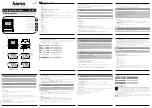
the components depending on which you choose.
•
For LEDs
: You need to connect P1 “VIN” to “COM” and choose 1k values for R38 and
R39. You need to take care of the polarity of the LEDs, following what is marked on the
board.
•
For neons
: You need to connect “170V” to “COM” and choose 120k values for R38 and
R39. The polarity of the neons does not matter.
•
Q3 - Q6 should be orientated with the flat side as shown on the board. Some FETs come
with the leads in a row rather than in a triangle. If this is the case, bend the middle lead
slightly so that it fits the holes in the board (see hint).
•
R17 is needed to bias the LDR ambient light detection circuit, to make sure that the LED
lights up reliably.
•
Mount the RGB LEDs close to the board, but
be careful not to strain the LED too much.
Normally it is best to mount the LEDs until
the “lump” in the leads (about 3 – 4mm
proud of the board). If you mount the LEDs
too high, the tubes have to be mounted much
too high from the board.
•
The “colon” LEDs need to be mounted proud
of the board, on moderately rigid extension
wires. It is not easy to estimate the height
they should be mounted at yet (it will
become clear once you mount the tubes), so
for the moment, make the leads longer than
you will need.
•
The RGB LEDs have a tiny “o” on the board to indicate where the common anode goes.
The anode is the
longest
lead of the RGB LED.
Hint:
MPSA42/2N7000 mounting
To mount the MSPA 42 transistor or
the 2N7000 FETs, bend the middle
lead back slightly. It will then fit in
the PCB without problems.
MPSA42/2N7000
The RGB LEDs should be close to
the board (but don't strain them)














































